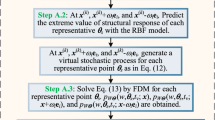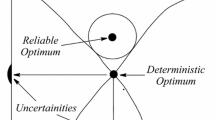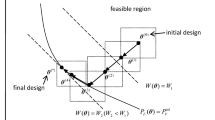Abstract
The present paper presents a framework for solving dynamic reliability–based design optimization (DRBDO) problems. The proposed approach is based on a sequential approximate programming technique, where the solution of the original design problem is obtained by converting it into a sequence of sub-optimization problems with a simple explicit algebraic structure. The technique is combined with the probability density evolution method (PDEM) for the purpose of estimating the reliability and/or the failure probability at the different designs in an efficient manner. The change of probability measure (COM), a strategy based on the Radon-Nikodym derivative, is employed to estimate the sensitivity information required by the optimization scheme. Based on this strategy, the sensitivity information can be obtained without any additional function evaluation. Thus, the numerical efforts associated with the reliability assessment and sensitivity analysis can be considerably reduced. The results of the numerical examples indicate that the proposed method is an effective and efficient tool for solving a class of DRBDO problems.



















Similar content being viewed by others
References
Agarwal H, Mozumder CK, Renaud JE, Watson LT (2007) An inverse-measure-based unilevel architecture for reliability-based design optimization. Struct Multidiscip Optim 33:217–227
Ang AH-S, Tang WH (2006) Probability concepts in engineering: emphasis on applications to civil and environmental engineering, 2nd edn. Wiley, Hoboken
Aoues Y, Chateauneuf A (2010) Benchmark study of numerical methods for reliability-based design optimization. Struct Multidiscip Optim 41:277–294
Au SK, Beck JL (2001) Estimation of small failure probabilities in high dimensions by subset simulation. Probabilist Eng Mech 16:263–277
Beck AT, Gomes WJS (2012) A comparison of deterministic, reliability-based and risk-based structural optimization under uncertainty. Probabilist Eng Mech 28:18–29
Carlon AG, Lopez RH, Espath LFR, Miguel LFF, Beck AT (2019) A stochastic gradient approach for the reliability maximization of passively controlled structures. Eng Struct 186:1–12
Chen JB, Chan JP (2019) Error estimate of point selection in uncertainty quantification of nonlinear structures involving multiple nonuniformly distributed parameters. Int J Numer Meth Eng 118:536–560
Chen JB, Li J (2005) Dynamic response and reliability analysis of non-linear stochastic structures. Probabilist Eng Mech 20:33–44
Chen JB, Li J (2007) The extreme value distribution and dynamic reliability analysis of nonlinear structures with uncertain parameters. Struct Saf 29:77–93
Chen JB, Wan ZQ (2019) A compatible probabilistic framework for quantification of simultaneous aleatory and epistemic uncertainty of basic parameters of structures by synthesizing the change of measure and change of random variables. Struct Saf 78:76–87
Chen JB, Wan ZQ, Beer M (2020) A global sensitivity index based on Fréchet derivative and its efficient numerical analysis (under review). Probabilist Eng Mech
Chen JB, Yang JY, Li J (2016) A GF-discrepancy for point selection in stochastic seismic response analysis of structures with uncertain parameters. Struct Saf 59:20–31
Chen JB, Zhang SH (2013) Improving point selection in cubature by a new discrepancy. SIAM J Sci Comput 35:A2121–A2149
Cheng GD, Xu L, Jiang L (2006) A sequential approximate programming strategy for reliability-based structural optimization. Comput Struct 84:1353–1367
Du XP, Chen W (2004) Sequential optimization and reliability assessment method for efficient probabilistic design. J Mech Des 126:225–233
Fadel GM, Riley MF, Barthelemy JM (1990) Two point exponential approximation method for structural optimization. Struct Optim 2:117–124
Fang T, Jiang C, Huang ZL, Wei XP, Han X (2019) Time-variant reliability-based design optimization using an equivalent most probable point. IEEE Trans Reliab 68:175–186
Fleury C, Braibant V (1986) Structural optimization: a new dual method using mixed variables. Int J Numer Meth Eng 23:409–428
Groenwold AA, Wood DW, Etman LFP, Tosserams S (2009) Globally convergent optimization algorithm using conservative convex separable diagonal quadratic approximations. AIAA J 47:2649–2657
Haftka RT, Gürdal Z (1992) Elements of structural optimization, 3rd edn. Kluwer, Dordrecht
Hu Z, Du XP (2016) Reliability-based design optimization under stationary stochastic process loads. Eng Optim 48:1296–1312
Ikhouane F, Rodellar J (2007) Systems with hysteresis: analysis, identification and control using the Bouc–Wen model. Wiley, Chichester
Jenkins WM (1991) Towards structural optimization via the genetic algorithm. Comput Struct 40:1321–1327
Jensen HA, Becerra LG, Valdebenito MA (2013) On the use of a class of interior point algorithms in stochastic structural optimization. Comput Struct 126:69–85
Jensen HA, Sepulveda JG (2011) Structural optimization of uncertain dynamical systems considering mixed-design variables. Probabilist Eng Mech 26:269–280
Jensen HA, Valdebenito MA, Schuëller GI, Kusanovic DS (2009) Reliability-based optimization of stochastic systems using line search. Comput Methods Appl Mech Eng 198:3915–3924
Jiang ZM, Li J (2016) Analytical solutions of the generalized probability density evolution equation of three classes stochastic systems (in Chinese). Chin J Theor Appl Mech 48:413–421
Kuschel N, Rackwitz R (1997) Two basic problems in reliability-based structural optimization. Math Method Oper Res 46:309–333
Lamberti L (2008) An efficient simulated annealing algorithm for design optimization of truss structures. Comput Struct 86:1936–1953
Li J, Chen JB (2004) Probability density evolution method for dynamic response analysis of structures with uncertain parameters. Comput Mech 34:400–409
Li J, Chen JB (2008) The principle of preservation of probability and the generalized density evolution equation. Struct Saf 30:65–77
Li J, Chen JB (2009) Stochastic dynamics of structures. Wiley, Singapore
Li J, Chen JB, Sun WL, Peng YB (2012) Advances of the probability density evolution method for nonlinear stochastic systems. Probabilist Eng Mech 28:132–142
Li X, Gong CL, Gu LX, Jing Z, Fang H, Gao RC (2019) A reliability-based optimization method using sequential surrogate model and Monte Carlo simulation. Struct Multidiscip Optim 59:439–460
Ma J, Gao W, Wriggers P, Chen JJ, Sahraee S (2011a) Structural dynamic optimal design based on dynamic reliability. Eng Struct 33:468–476
Ma J, Wriggers P, Gao W, Chen JJ, Sahraee S (2011b) Reliability-based optimization of trusses with random parameters under dynamic loads. Comput Mech 47:627–640
Melchers RE, Beck AT (2018) Structural reliability analysis and prediction, 3rd edn. Wiley, Hoboken
Moustapha M, Sudret B (2019) Surrogate-assisted reliability-based design optimization: a survey and a unified modular framework. Struct Multidiscip Optim 60:2157–2176
Nie J, Ellingwood BR (2000) Directional methods for structural reliability analysis. Struct Saf 22:233–249
Nocedal J, Wright SJ (2006) Numerical optimization, 2nd edn. Springer-Verlag, New York
Papadopoulos V, Kalogeris I (2016) A Galerkin-based formulation of the probability density evolution method for general stochastic finite element systems. Comput Mech 57:701–716
Perez RE, Behdinan K (2007) Particle swarm approach for structural design optimization. Comput Struct 85:1579–1588
Pradlwarter HJ, Schuëller GI, Dorka U (1998) Reliability of MDOF-systems with hysteretic devices. Eng Struct 20:685–691
Prasad B (1983) Explicit constraint approximation forms in structural optimization part 1: analyses and projections. Comput Methods Appl Mech Eng 40:1–26
Schmit LA Jr, Farshi B (1974) Some approximation concepts for structural synthesis. AIAA J 12:692–699
Suksuwan A, Spence SMJ (2018) Optimization of uncertain structures subject to stochastic wind loads under system-level first excursion constraints: a data-driven approach. Comput Struct 210:58–68
Svanberg K (2002) A class of globally convergent optimization methods based on conservative convex separable approximations. SIAM J Optim 12:555–573
Taflanidis AA (2010) Reliability-based optimal design of linear dynamical systems under stochastic stationary excitation and model uncertainty. Eng Struct 32:1446–1458
Taflanidis AA, Beck JL (2008) Stochastic subset optimization for optimal reliability problems. Probabilist Eng Mech 23:324–338
Tao WF, Li J (2017) An ensemble evolution numerical method for solving generalized density evolution equation. Probabilist Eng Mech 48:1–11
Valdebenito MA, Pérez CA, Jensen HA, Beer M (2016) Approximate fuzzy analysis of linear structural systems applying intervening variables. Comput Struct 162:116–129
Valdebenito MA, Schuëller GI (2010) A survey on approaches for reliability-based optimization. Struct Multidiscip Optim 42:645–663
Valdebenito MA, Schuëller GI (2011) Efficient strategies for reliability-based optimization involving non-linear, dynamical structures. Comput Struct 89:1797–1811
Wan ZQ, Chen JB, Li J, Ang AHS (2020) An efficient new PDEM-COM based approach for time-variant reliability assessment of structures with monotonically deteriorating materials. Struct Saf 82:101878
Wang J, Katafygiotis LS (2014) Reliability-based optimal design of linear structures subjected to stochastic excitations. Struct Saf 47:29–38
Yang DX, Liu LB (2014) Reliability analysis of structures with complex limit state functions using probability density evolution method. Struct Multidiscip Optim 50:275–286
Yang JS, Chen JB, Jensen HA (2020) A PDEM-based method for structural optimization under dynamic reliability constraints. In: 7th International Symposium on Reliability Engineering and Risk Management, Beijing China
Yang MG, Chen ZQ, Hua XG (2011) An experimental study on using MR damper to mitigate longitudinal seismic response of a suspension bridge. Soil Dyn Earthq Eng 31:1171–1181
Yi P, Cheng GD, Jiang L (2008) A sequential approximate programming strategy for performance-measure-based probabilistic structural design optimization. Struct Saf 30:91–109
Zuev KM, Beck JL (2013) Global optimization using the asymptotically independent Markov sampling method. Comput Struct 126:107–119
Funding
This work received supports from the National Natural Science Foundation of China (Grant Nos. 51725804, 11672209, and 51538010), the NSFC-DFG joint project (Grant No. 11761131014), the Committee of Science and Technology of Shanghai China (Grant No. 18160712800), and the Research Fund for State Key Laboratories of Ministry of Science and Technology of China (SLDRCE19-B-23). In addition, support of CONICYT (National Commission for Scientific and Technological Research) under grant number 1200087 was also received.
Author information
Authors and Affiliations
Corresponding author
Ethics declarations
Conflict of interest
The authors declare that they have no conflict of interest.
Additional information
Responsible Editor: Jianbin Du
Publisher’s note
Springer Nature remains neutral with regard to jurisdictional claims in published maps and institutional affiliations.
Appendices
Appendix 1
Generally, four steps are involved in the solution of the generalized density evolution equation (GDEE)
-
Step A.1:
Discretize the probability-assigned space, ΩΘ, by the optimal point selection strategy, e.g., the GF discrepancy minimization-based method (Chen and Chan 2019; Chen et al. 2016; Chen and Zhang 2013). The selected point set is denoted by \( {\mathcal{P}}_{\mathrm{sel}}=\left\{\left.\left({\boldsymbol{\theta}}_q,{P}_q\right)\right|q=1,2,\cdots, {n}_{\mathrm{sel}}\right\} \), in which nsel is the number of representative points and θq = (θ1, q, θ2, q, ⋯, θs, q) is the qth representative point with assigned probability
where Vq stands for the representative domain determined by the Voronoi cell (Li and Chen 2009) of the representative point θq.
-
Step A.2:
Perform the dynamic analysis of the system to obtain the velocity response \( \dot{Z}\left({\boldsymbol{\theta}}_q,t\right) \) for each representative point θq, q = 1, 2, ⋯, nsel.
-
Step A.3:
For each representative point θq, introduce the corresponding velocity response \( \dot{Z}\left({\boldsymbol{\theta}}_q,t\right) \) into the GDEE, i.e., (11). Solve the equation by the finite difference method with total variation diminishing (TVD) scheme (Li and Chen 2004). The initial condition for the representative point θq is
-
Step A.4:
Obtain the instantaneous PDF of the response Z(θ, t) by synthesizing all the results related to the representative points
In the present paper, the above point-evolution pathway is adopted. A detailed implementation of the solution of the GDEE can be found in (Chen et al. 2016; Chen and Zhang 2013; Li and Chen 2004; Li and Chen 2009). It is noteworthy that the GDEE can also be solved in the ensemble-evolution pathway (Li et al. 2012; Tao and Li 2017).
Appendix 2
The error estimation of the PDEM is established by an extension of Koksma-Hlawka inequality (Chen and Chan 2019; Chen et al. 2016; Chen and Zhang 2013)
in which f(⋅) is a function representing the stochastic system; \( {\mathcal{P}}_{\mathrm{sel}}=\left\{\left.\left({\boldsymbol{\theta}}_q,{P}_q\right)\right|q=1,2,\cdots, {n}_{\mathrm{sel}}\right\} \) denotes the representative point set and the corresponding assigned probabilities; R(f) is a probabilistic integral and it stands for the reliability in the present paper; \( Q\left(f,{\mathcal{P}}_{\mathrm{sel}}\right) \) is the reliability evaluated by the PDEM; TV(f) is a measure of the irregularity of the function f with respect to its arguments, and it remains constant for a given f; and \( {D}_{\mathrm{EF}}\left({\mathcal{P}}_{\mathrm{sel}}\right) \) is the EF-discrepancy which is a measure of the uniformity of the point set.
In the present formulation, representative points are selected by the GF-discrepancy minimization-based method. The relationship between the EF-discrepancy and GF-discrepancy takes the form (Chen and Chan 2019):
where \( {D}_{\mathrm{GF}}\left({\mathcal{P}}_{\mathrm{sel}}\right) \) denotes the GF-discrepancy of the representative point set.
Therefore, the less is the GF-discrepancy of the representative point set, the less is the error in the reliability assessment. In general, the GF-discrepancy decreases when the number of representative points increases. As a result, the evaluation of reliability will become more accurate when more representative points are involved.
For a full description on EF-discrepancy, GF-discrepancy, extended Koksma-Hlawka inequality and the error estimation of the PDEM, the reader is referred to (Chen and Chan 2019).
Replication of results
Data in the present manuscript are available by request for the replication of results.
Rights and permissions
About this article
Cite this article
Chen, J., Yang, J. & Jensen, H. Structural optimization considering dynamic reliability constraints via probability density evolution method and change of probability measure. Struct Multidisc Optim 62, 2499–2516 (2020). https://doi.org/10.1007/s00158-020-02621-4
Received:
Revised:
Accepted:
Published:
Issue Date:
DOI: https://doi.org/10.1007/s00158-020-02621-4




